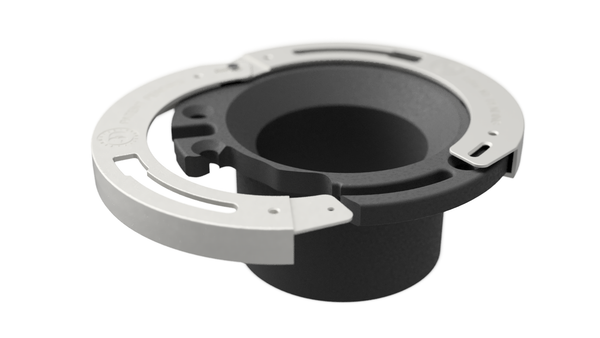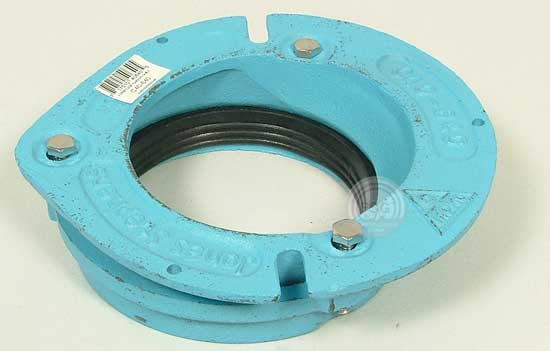The article further down on the subject of Fix a Broken Toilet Flange is really fascinating. Read it yourself and figure out what you think about it.

Introduction:
Recognizing the Importance of a Toilet Flange:
In the world of plumbing, the often-overlooked toilet flange plays a pivotal duty in ensuring the smooth procedure of your washroom components. Acting as a crucial adapter in between your toilet and the underlying drain, the commode flange functions as the unrecognized hero of your plumbing system. Without this durable part, your bathroom would certainly be prone to instability and leaks, possibly leading to costly repair work and inconvenience. As a result, understanding the relevance of an effectively set up and maintained commode flange is vital for any kind of home owner embarking on plumbing tasks or dealing with repair work demands.
Why Proper Installation and Maintenance Matter:
Appropriate installment and meticulous upkeep of the toilet flange are crucial for protecting the honesty of your plumbing infrastructure. A thoroughly installed flange not only supports your commode securely in position yet additionally forms an impervious seal, warding off the dangers of leaks and odours. By accepting a proactive approach to flange upkeep, you can mitigate the threat of disruptive plumbing issues and maintain the serenity of your house setting. Throughout this insightful guide, we'll unwind the intricacies of bathroom flange setup and repair service, equipping you with the knowledge and knowledge to browse these crucial tasks adeptly.
Best Practices When Installing a Toilet Flange:
Guaranteeing a smooth commode flange setup calls for adherence to a collection of finest practices that ensure resilience and capability. Begin by carefully evaluating your devices and products, guaranteeing you have the needed devices for the job ahead. Choosing the ideal flange product, whether PVC, ABS, or cast iron, is paramount, as it figures out the durability and performance of your plumbing component. Moreover, evaluating existing plumbing problems, such as looking for damage or rust, is important for preemptively dealing with possible problems and ensuring a smooth installation procedure. By taking on these preparatory actions, you established a strong structure for an effective toilet flange installment, minimising the chance of future issues and assisting in long-term upkeep.
As soon as sufficiently ready, proceed with the cautious elimination of the old flange, following a methodical technique to avoid causing damage to surrounding elements. Utilize strategies customized to resolve stubborn or rusted flanges, ensuring their swift and safe elimination without compromising the integrity of the surrounding plumbing infrastructure. With the old flange removed, meticulously set up the brand-new replacement flange, choosing one that fits comfortably and safely into place. Effectively protecting the flange to the flooring using screws or adhesive is vital, as it ensures stability and stops future leakages. By adhering to these finest techniques during the installation process, you prepared for a robust and trustworthy toilet flange setup that stands up to the examination of time.
Mounting a New Toilet Flange:
When setting up a new toilet flange, the first step is to select the best replacement for your plumbing configuration. Consider elements such as the product of the flange, with options including PVC, ABS, or cast iron. PVC flanges are known for their cost and resistance to rust, making them a prominent selection for DIY fanatics. Abdominal flanges provide comparable benefits to PVC but boast added toughness, making them suitable for high-traffic areas or business setups. Cast iron flanges, renowned for their toughness and durability, are ideal for setups where toughness is paramount. Additionally, make sure that the substitute flange is appropriately sized and fits comfortably into location to develop a watertight seal and protect against leaks.
Safeguarding the Flange to the Floor:
As soon as you've picked the appropriate replacement flange, it's essential to secure it effectively to the flooring to guarantee stability and stop future concerns. Begin by positioning and straightening the flange properly over the drain, making certain that it sits flush with the flooring surface area. Relying on the sort of flange and your certain setup choices, you can secure the flange to the flooring utilizing screws or glue. If utilizing screws, be sure to utilize corrosion-resistant alternatives to avoid rusting in time. Additionally, adhesive can provide a safe bond between the flange and the flooring, making sure a strong and reputable installation. By adhering to these actions and taking the required safety measures, you can install a new bathroom flange with self-confidence, making sure a durable and leak-free plumbing component.
Ideal Practices When Repairing a Broken Flange:
Fixing a damaged bathroom flange demands careful attention to information and adherence to best practices to make sure an enduring option. Begin by extensively evaluating the extent of the damages and identifying the underlying reason, whether it be corrosion, cracks, or misalignment. This analysis will assist your repair service technique, permitting you to select the most proper techniques and materials for restoring the flange to its ideal problem. Additionally, think about the surrounding plumbing facilities and flooring security to deal with any kind of potential contributing variables and protect against future issues from emerging. By performing an extensive evaluation and analysis, you lay the groundwork for an effective and long-lasting repair service procedure that resolves the source of the trouble.
With a clear understanding of the flange's condition and the factors affecting its damages, proceed with the repair work procedure utilizing precision and treatment. Depending upon the seriousness of the damage, you might select repair work approaches such as epoxy putty, repair work flange packages, or partial flange substitutes. Make certain that the selected repair technique effectively addresses the particular concerns at hand while maintaining the architectural integrity and functionality of the flange. In addition, take positive measures to strengthen the fixed flange and protect against future damages, such as using sealant or waterproofing materials to guard versus leaks and deterioration. By sticking to these finest methods during the repair procedure, you can recover your busted flange to optimum problem, making sure the long-term dependability and performance of your plumbing system.
Sorts Of Toilet Flanges:
Understanding the different types of commode flanges is crucial for picking one of the most appropriate option for your plumbing needs. PVC, ABS, and cast iron are among the common materials made use of in commode flange building and construction, each offering unique benefits and factors to consider. PVC flanges, known for their affordability and rust resistance, are favoured for their simplicity of installment and toughness. Abdominal muscle flanges, comparable to PVC in terms of cost and ease of installation, are treasured for their robustness and resistance to influences. On the other hand, cast iron flanges, renowned for their outstanding strength and durability, are typically liked for high-traffic areas or commercial settings where durability is extremely important. By acquainting yourself with the attributes of each material, you can make an educated choice when selecting a commode flange that aligns with your particular requirements and choices.
In addition to material factors to consider, bathroom flanges likewise come in numerous design and styles to fit different plumbing setups and installment preferences. Offset flanges, for instance, are developed to suit toilets mounted on floors that are not level or where the drain is located off-centre. Similarly, repair flanges, also called fixing rings or spacer rings, are utilized to deal with concerns such as split or damaged flanges without the requirement for considerable plumbing adjustments. In addition, adjustable flanges use versatility ready, allowing for accurate alignment and fit during setup. By exploring the varied variety of bathroom flange types and styles offered, you can choose the option that ideal matches your plumbing setup and installation needs, making sure a seamless and trusted service for your shower room components.
Specialized Options:
Along with standard toilet flanges, there are specialty options available to attend to details plumbing challenges and installation choices. One such option is the balanced out flange, which is created to fit toilets set up on floors that are uneven or where the drain lies off-centre. Offset flanges include a special style that permits the bathroom to be positioned at a minor angle, making up for unequal floor covering or misaligned plumbing links. This ingenious remedy guarantees a secure and secure installment, getting rid of the demand for costly and time-consuming floor progressing or pipeline moving. By including a countered flange right into your plumbing setup, you can overcome common setup barriers and achieve a professional-quality result easily.
One more specialized choice worth considering is the repair service flange, likewise known as a repair work ring or spacer ring. Repair flanges are particularly developed to deal with issues such as split or broken bathroom flanges without the requirement for extensive plumbing alterations. These flexible elements can be set up directly over the existing flange, supplying a strong and trusted base for protecting the bathroom in position. Repair flanges come in numerous sizes and arrangements to suit various flange sizes and installation demands, making them a hassle-free and economical option for dealing with flange-related troubles. Whether you're managing a minor flange repair work or an extra complex plumbing issue, including specialty options like offset and fixing flanges can improve the installment procedure and ensure durable performance for your shower room fixtures.
Final thought:
To conclude, grasping the art of toilet flange installment and repair work is vital for maintaining a useful and leak-free plumbing system in your house. By recognizing the significance of an appropriately mounted flange and adhering to ideal techniques throughout the procedure, you can make certain the durability and dependability of your washroom components. Whether you're picking the appropriate sort of flange, conducting repair services, or checking out specialized choices, attention to information and careful execution are crucial. Regular maintenance and positive troubleshooting can aid prevent costly plumbing problems and protect the harmony of your family setting. Armed with the knowledge and skills acquired from this detailed guide, you can take on bathroom flange installment and fixing with confidence, empowering you to guard your plumbing system for many years ahead.
How to Replace a Toilet Flange
The toilet flange is the part that keeps your toilet attached to the drain. A broken toilet flange will result in your toilet moving around and can even cause it to leak.
A broken toilet can be such a headache and the leaking water can even cause further damage. Many people don’t know about the different elements of replacing a toilet or fitting a new toilet, and it’s important to know these skills when you’re a homeowner.
This article will walk you through how to quickly and correctly do a toilet flange repair.
How to Replace a Toilet Flange
A toilet flange is a critical element of a toilet, but it serves two separate functions. For instance, a toilet flange secures your toilet unit onto the ground and connects the toilet bowl to the wastewater line.
Often, a toilet flange is already in place when installing a toilet, so many homes have these features but never think of them until they are broken. Therefore, you need to know when to replace a toilet flange.
Remove the Toilet
The first stage is removing the toilet and disconnecting the structure from the water supply. You can close the knob at the back of the toilet and empty the toilet tank several times.
After this, you should remove the water hose from the toilet. It’s essential to cover your bathroom floor with newspaper or a tarp to ensure there’s no external damage to your space.
This can be a complicated process, so getting professional help may be necessary if you don’t feel confident about replacing a toilet flange. When you work with an experienced professional, you can ensure the job is done correctly.
Unscrew Two Nuts and Bolts
The two nuts and bolts are the parts that hold the toilet to the flange and floor, so you need to tackle this part next. You can use an adjustable wrench if the nuts are secure and too tight.
After this, you can set the nuts aside in a container and reattach the toilet when the flange is completely repaired.
Remove the Old Wax
Next, after you’ve removed the toilet and nuts and bolts features, you should remove the old wax that sealed the toilet to the flange. You can quickly eliminate the old wax with a putty knife or other similar tool.
Work your way down the build-up of old wax until you reach the top of the toilet flange.
Remove the Flange
Once you reach the flange structure, you can search for the screws outside the part. All you need to remove the screws is a multi-head screwdriver, allowing you to remove different screws.
You can remove the flange and clean it with disinfectant or a wipe to sanitize the surface area. It’s also a good idea to stuff an old towel or cloth into the space to prevent odors and gasses from oozing from the area.
This is where you need to measure the diameter of the outflow pipe’s mouth to find the identical part to replace the toilet flange. You must have exact measurements when searching for a new flange.
Otherwise, you will buy a new toilet flange that can be used in your bathroom.
You can also take the old toilet flange in a secure bag to your local hardware shop if you want to make a direct comparison with a new product. You must also buy sealing wax for the new toilet flange.
If you need help buying a new toilet flange, a professional plumber can help or an employee at your local store.
Apply New Flange and Fit Toilet
At this point, you can fit the new toilet flange following the instructions given with the product, or you can hire a professional to do the job for you. You should also apply the new seal wax around the mouth.
This will allow the toilet flange to stay in place and not become broken again shortly.
Finally, you can fit the toilet structure back in place by securing the nuts and bolts again. You should reattach the water supply and test the flush to check that the water is running correctly.
To test the water supply, you can flush the toilet several times and wait for the water to fill up and empty repeatedly.
The last step is to tidy the bathroom space and clear away the dirty towels or newspapers. It’s a good idea to clean the floors with a strong disinfectant to eliminate the odors left behind.
With experience, you can fix the toilet flange in no time. But, if you’ve never handled these toilet parts, you should hire a professional plumber to take care of them.
Thankfully, our team is here for you. We have the best plumbers in Detroit to help you fix any toilet issues you encounter at home.
https://waterworkplumbing.com/how-to-replace-a-toilet-flange/

I'm very fascinated with How to Repair a Toilet Flange and I really hope you enjoyed reading my blog entry. Enjoyed reading our entry? Please quickly share it. Help others find it. We truly appreciate your readership.
Schedule A Free Estimate
 Edward Furlong Then & Now!
Edward Furlong Then & Now! Ross Bagley Then & Now!
Ross Bagley Then & Now! Charlie Korsmo Then & Now!
Charlie Korsmo Then & Now! Naomi Grossman Then & Now!
Naomi Grossman Then & Now! Ryan Phillippe Then & Now!
Ryan Phillippe Then & Now!